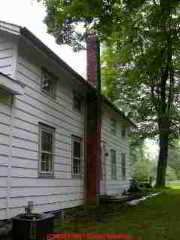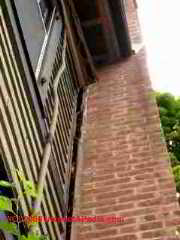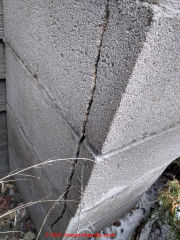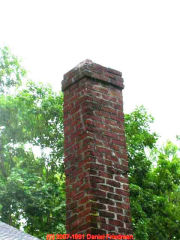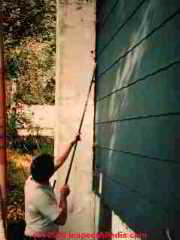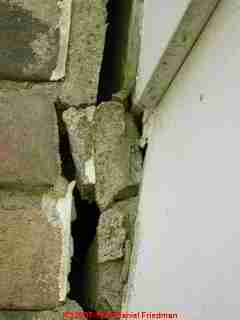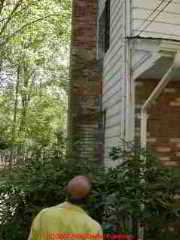 Chimney Leaning, Building Separation, Movement
Chimney Leaning, Building Separation, Movement
Inspection, Diagnosis, Repair
- POST a QUESTION or COMMENT about the diagnosis & repair of moving or leaning chimneys or chimneys separating from the building
Chimney leaning or separation diagnosis:
This article describes the detection and diagnosis of leaning or separating chimneys that have moved away from their building. Because a moving masonry chimney is likely to be unsafe, risking fire and carbon monoxide gas hazards, inspectors and building owners need to be alert for clues indicating that the chimney has moved or is experiencing ongoing movement. Expert chimney evaluation and repair are required.
InspectAPedia tolerates no conflicts of interest. We have no relationship with advertisers, products, or services discussed at this website.
- Daniel Friedman, Publisher/Editor/Author - See WHO ARE WE?
Chimney Leaning, Building Separation, Movement - Outdoors
Watch out: Any movement in a masonry chimney risks damage to its interior liner and could be a safety concern.
When we see signs of movement in any chimney, particularly a masonry chimney, there is risk that the chimney's internal flue is damaged, risking a building fire or fatal carbon monmoxide poisoning. Be sure that your chimney flue is inspected for safety.
The photo above shows even from a distance that the chimney is curved, so we'd be alert for flue damage or for evidence that the chimney has separated from the building.
Most-Common Chimney Movement: Leaning
Above: significant movement of a brick chimney away from the building. Notice that the gap between chimney and wall is wider as we look up, closer to the roof.
When a chimney has separated from a building, usually the problem is in the chimney or its supporting footing, causing it to lean away from the structure. It would be possible but rare for the opposite case to occur, that is, for the building to move away from the chimney.
Usually you will see that the gap between chimney and building wall is greater high on the wall and less (the gap is smaller) lower down, closer to the ground: a pattern that confirms that the chimney is leaning away from the building.
You might also simply measure both chimney and building wall to see which is plumb. Use a plumb line to measure changes in chimney or wall angle over a higher distance to get more-accurate results.
At BULGE or LEAN MEASUREMENTS we give details of how to measure leaning or bulging bowing chimneys or walls or foundations.
Remember to inspect inside the building for other signs of chimney movement or damage that you might see in a basement, in the attic or roof cavity, or if there is a fireplace, in the fireplace or at the fireplace hearth.
At CHIMNEY MOVEMENT CAUSES we catalog the various reasons that you might see chimneys that are leaning, bulged, or for masonry chimneys cracked.
At CHIMNEY MOVEMENT, ONGOING vs STATIC we discuss indications that a chimney crack or separation gap was due to a single event or is an ongoing problem.
Other Types of Chimney Movement: Cracks, Curves or Bulges
Vertical cracks through the actual blocks of a concrete block chimney (above) are probably not a chimney leaning problem but more-likely are due to frost, water, or heat damage.
Bulged or curved chimneys at mid height are a different problem and are probably not caused by a bad chimney footing.
Rather, chimney may appear to curve away from the building at mid-height (below) when it has not been properly secured to the building with lateral support.
A brick chimney that is curved, especially if the curve is just above the roof line, may also be caused by a combination of lacking an interior flue liner and sulphation - a process we describe in detail
at CURVED BRICK CHIMNEYS, SULPHATION.
The second above shows a chimney to viewed from the ground, with our camera zoomed, and photographed during a rainstorm - not an unusual inspection conation.
We can see some incomplete repairs to a brick at the chimney top and other spalled, loose bricks. This chimney needs further inspection and probably some repairs, as well as a rain cap.
The condition of the top exterior section of the chimney and the exposed flue liner will generally reveal the soundness of the chimney above the roof line. The exterior of the upper portion of a chimney can be seen from the ground level though not in detail.
Below we show more photos of chimneys that are cracked, leaning, or separated from their building.
We identify clues indicating chimney movement, evaluate the extent of chimney movement, the probability of internal flue damage (an unsafe condition and a fire and carbon monoxide hazard), the probable cause of chimney separation and movement, and the chimney repairs that are needed.
Above: our client is pointing to a gap seen between this masonry block chimney and the building wall. Below in our photo we take a closer look.
Chimney Movement detected outdoors:
The photographs just above show a chimney which probably lacked a good footing, possibly aggravated in its lean by roof spillage onto the area where a footing should have hold the chimney steady.
A careful look at the photo above suggests that there have been prior attempts to "repair" this gap simply by adding concrete, as we see at least two layers of different concrete material; but the chimney has continued to move awayu from the building.
Movement at both of these chimneys has been significant, the chimney interior and fireplace are likely to be damaged and unsafe, and major repairs are needed.
Bad Moving Chimney Repairs & Attempts to Hide Chimney Movement
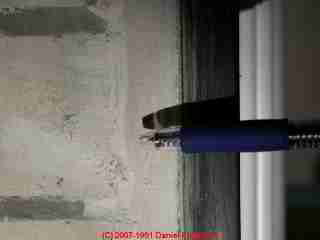
Watch out: Attempts to hide chimney movement can be dangerous since if there is a safety problem the building owner or inspector may not pick up its clues.
The fresh and thick band of caulk between the chimney and the wall as shown in this photograph were traced to a chimney separation that had been "repaired" simply by more caulking at the wall.
Because caulk is flexible, if it has been recently applied caulking may hide an ongoing chimney movement problem. But even if the chimney is no longer moving (or we think it is not moving) an inspection for flue safety and fireplace safety are essential.
The observation of evidence of movement in chimneys was introduced
This article series on diagnosing cracked, leaning, or moving chimneys includes a series of detailed diagnostic articles on diagnosing chimney cracks and movement.
Remember: Movement such as curving or leaning or separation from the building, especially
in masonry chimneys, can cause damage to the flue liner or
openings that might admit sparks (fire risk) or gases (carbon monoxide hazards)
into the building structure or even into occupied spaces.
...
Continue reading at CHIMNEY INSPECTION from GROUND or select a topic from the closely-related articles below, or see the complete ARTICLE INDEX.
Or see these
Recommended Articles
- CHIMNEY COLLAPSE RISKS, REPAIRS
- CHIMNEY CRACK DIAGNOSIS
- CHIMNEY DAMAGE by LEAKS & FROST
- CHIMNEY FLUE INSPECTION CAMERA
- CHIMNEY INSPECTION, FLUE INTERIOR
- CHIMNEY INSPECTION from GROUND
- CHIMNEY LEANING, SEPARATION, MOVEMENT
- CHIMNEY LEANING, REPAIR OPTIONS
- CHIMNEY MOVEMENT, ONGOING vs STATIC
- CURVED BRICK CHIMNEYS, SULPHATION - other examples of cracking, moving chimneys
Suggested citation for this web page
CHIMNEY LEANING, SEPARATION, MOVEMENT at InspectApedia.com - online encyclopedia of building & environmental inspection, testing, diagnosis, repair, & problem prevention advice.
Or see this
INDEX to RELATED ARTICLES: ARTICLE INDEX to CHIMNEYS & FLUES
Or use the SEARCH BOX found below to Ask a Question or Search InspectApedia
Ask a Question or Search InspectApedia
Questions & answers or comments about the diagnosis & repair of moving or leaning chimneys.
Try the search box just below, or if you prefer, post a question or comment in the Comments box below and we will respond promptly.
Search the InspectApedia website
Note: appearance of your Comment below may be delayed: if your comment contains an image, photograph, web link, or text that looks to the software as if it might be a web link, your posting will appear after it has been approved by a moderator. Apologies for the delay.
Only one image can be added per comment but you can post as many comments, and therefore images, as you like.
You will not receive a notification when a response to your question has been posted.
Please bookmark this page to make it easy for you to check back for our response.
IF above you see "Comment Form is loading comments..." then COMMENT BOX - countable.ca / bawkbox.com IS NOT WORKING.
In any case you are welcome to send an email directly to us at InspectApedia.com at editor@inspectApedia.com
We'll reply to you directly. Please help us help you by noting, in your email, the URL of the InspectApedia page where you wanted to comment.
Citations & References
In addition to any citations in the article above, a full list is available on request.
- Fire Inspector Guidebook, A Correlation of Fire Safety Requirements Contained in the 1987 BOCA National Codes, (newer edition available), Building Officials and Code Administrators International, Inc. (BOCA), Country Club HIlls, IL 60478 312-799-2300 4th ed. Note: this document is reissued every four years. Be sure to obtain the latest edition.
- New York 1984 Uniform Fire Prevention and Building Code, Article 10, Heating, Ventilating, and Air Conditioning Requirements
- New York 1979 Uniform Fire Prevention & Building Code, The "requirement" for 8" of solid masonry OR for use of a flue liner was listed in the One and Two Family Dwelling Code for New York, in 1979, in Chapter 9, Chimneys and Fireplaces, New York 1979 Building and Fire Prevention Code:
- "Top Ten Chimney (and related) Problems Encountered by One Chimney Sweep," Hudson Valley ASHI education seminar, 3 January 2000, contributed by Bob Hansen, ASHI
- Chimney Inspection Checklist, Carson Dunlop, Associates, Toronto, Ontario
- "Rooftop View Turns to Darkness," Martine Costello, Josh Kovner, New Haven Register, 12 May 1992 p. 11: Catherine Murphy was sunning on a building roof when a chimney collapsed; she fell into and was trapped inside the chimney until rescued by emergency workers.
- "Chimneys and Vents," Mark J. Reinmiller, P.E., ASHI Technical Journal, Vol. 1 No. 2 July 1991 p. 34-38.
- "Chimney Inspection Procedures & Codes," Donald V. Cohen was to be published in the first volume of the 1994 ASHI Technical Journal by D. Friedman, then editor/publisher of that publication. The production of the ASHI Technical Journal and future editions was cancelled by ASHI President Patrick Porzio. Some of the content of Mr. Cohen's original submission has been included in this more complete chimney inspection article: CHIMNEY INSPECTION DIAGNOSIS REPAIR . Copies of earlier editions of the ASHI Technical Journal are available from ASHI, the American Society of Home Inspectors.
- Chimney & Stack Inspection Guidelines, American Society of Civil Engineers, 2003 - These guidelines address the inspection of chimneys and stacks. Each guideline assists owners in determining what level of inspection is appropriate to a particular chimney and provides common criteria so that all parties involved have a clear understanding of the scope of the inspection and the end product required. Each chimney or stack is a unique structure, subject to both aggressive operating and natural environments, and degradation over time. Such degradation may be managed via a prudent inspection program followed by maintenance work on any equipment or structure determined to be in need of attention. Sample inspection report specifications, sample field inspection data forms, and an example of a developed plan of a concrete chimney are included in the guidelines. This book provides a valuable guidance tool for chimney and stack inspections and also offers a set of references for these particular inspections.
- Fireplaces, a Practical Design Guide, Jane Gitlin
- Fireplaces, Friend or Foe, Robert D. Mayo
- NFPA 211 - Standards for Chimneys & Fireplaces, NFPA 211: Standard for Chimneys, Fireplaces, Vents, and Solid Fuel-Burning Appliances, 2006 Edition (older editions and standards are found at the same bookstore)
- Principles of Home Inspection: Chimneys & Wood Heating, in (Principles of Home Inspection), Carson Dunlop, Associates, Toronto, Ontario
- U.S. vs. Canadian Unlined Masonry Chimney Flue Requirements & Case Study
- NFPA 211 - 3-1.10 - Relining guide for chimneys
- NFPA 211 - 3-2 - Construction of Masonry Chimneys
- NFPA 211 - 3-3 - Termination Height for chimneys
- NFPA 211 - 3-4 - Clearance from Combustible Material
- NFPA 54 - 7-1 - Venting of Equipment into chimneys
- Brick Institute of America - Flashing Chimneys
Brick Institute of America - Proper Chimney Crowns
Brick Institute of America - Moisture Resistance of Brick - American Gas Association - New Vent Sizing Tables
- Chimney Safety Institute of America - Chimney Fires: Causes, Effects, Evaluation
- National Chimney Sweep Guild - Yellow Pages of Suppliers
- In addition to citations & references found in this article, see the research citations given at the end of the related articles found at our suggested
CONTINUE READING or RECOMMENDED ARTICLES.
- Carson, Dunlop & Associates Ltd., 120 Carlton Street Suite 407, Toronto ON M5A 4K2. Tel: (416) 964-9415 1-800-268-7070 Email: info@carsondunlop.com. Alan Carson is a past president of ASHI, the American Society of Home Inspectors.
Thanks to Alan Carson and Bob Dunlop, for permission for InspectAPedia to use text excerpts from The HOME REFERENCE BOOK - the Encyclopedia of Homes and to use illustrations from The ILLUSTRATED HOME .
Carson Dunlop Associates provides extensive home inspection education and report writing material. In gratitude we provide links to tsome Carson Dunlop Associates products and services.


